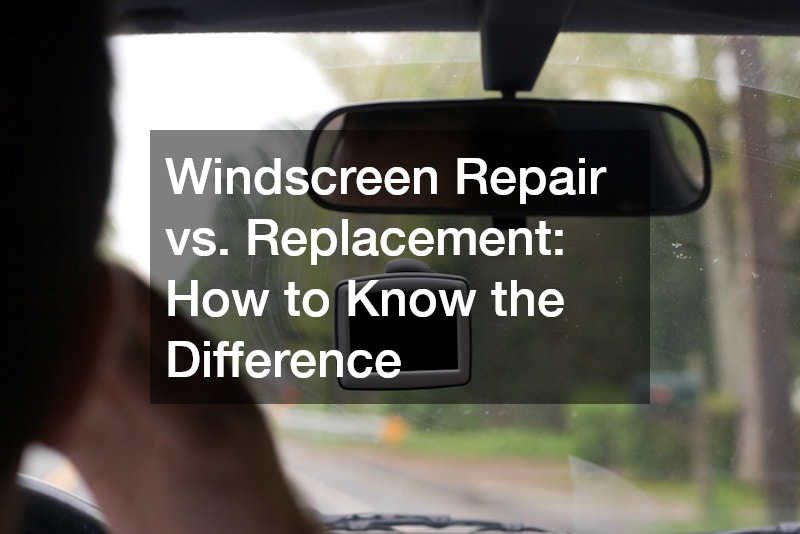Windscreen Repair vs. Replacement How to Know the Difference

Windscreen repair is often the first solution considered when dealing with a chipped or cracked windscreen, something most drivers will face at some point. It might happen after a stone flicks up on the highway or from sudden weather changes. In either case, taking prompt action can prevent further damage and keep you safe on the road. Understanding whether you need a full replacement or if windscreen repair is enough will help you make the right choice and potentially save money.
A damaged windscreen affects not only visibility but also the structural integrity of your vehicle. Knowing how to assess the damage and when to call a professional is key to avoiding costly issues down the track.
When Windscreen Repair Is Enough
Not every chip or crack means you need a new windscreen. In many cases, windscreen repair is a safe and effective solution. Small chips, especially those caused by stones, can often be repaired if they are no larger than a coin and do not extend across the driver’s line of sight.
Modern repair methods use a special resin that is injected into the damaged area. Once cured and polished, the resin restores clarity and strength to the glass. A professional repair stops the chip from spreading and helps you avoid a more expensive replacement later.
Repairs are often completed in under an hour and may even be covered by insurance. The key is acting quickly before the damage worsens due to road vibration, weather or additional impacts.
When Replacement Is Necessary
In some cases, windscreen repair will not be enough. If the crack is too long, extends to the edge of the glass or sits directly in the driver’s line of vision, a full windscreen replacement is usually required. Larger damage can weaken the glass and compromise the structural support provided by the windscreen during a collision.
Cracks over 30 centimetres or chips larger than five centimetres generally cannot be repaired safely. Multiple cracks, deep impact points or damage affecting sensors used in advanced driver assistance systems are also signs that replacement is the better option.
Driving with a severely damaged windscreen can result in fines or even vehicle defect notices, so it is important to get professional advice as soon as possible.
Assessing the Damage
To determine whether windscreen repair is possible, inspect the damage closely or take your vehicle to an expert. A qualified technician will consider the size, depth, location and type of damage. They will also assess how long the damage has been there, as older chips that have collected dirt may be harder to repair cleanly.
Some types of damage, such as bullseyes or small star cracks, are more likely to be repairable. On the other hand, long-running cracks or combination breaks usually indicate the need for replacement.
Avoid touching or taping the crack, as this can trap moisture or dirt and reduce the chance of a successful repair.
Cost Differences Between Repair and Replacement
In most cases, windscreen repair is much cheaper than replacement. Repairs cost less because they involve fewer materials and take less time. If you have comprehensive car insurance, your policy may cover windscreen repairs with no excess or claim impact.
Replacement costs vary depending on the make and model of your vehicle, the availability of glass and whether you need calibration for systems like lane assist or rain sensors. These features are becoming more common in modern vehicles and can increase the overall cost.
Getting a professional assessment early can help avoid the higher cost of full replacement when a simple repair could have done the job.
Safety and Roadworthiness
Your windscreen plays a vital role in keeping your car safe. It provides visibility, supports the roof in case of a rollover and helps ensure airbags deploy correctly. Any damage that affects these functions should be addressed immediately.
A proper windscreen repair restores strength to the glass and maintains the safety standards of your vehicle. Repairs done by an unqualified person or delayed repairs may not hold up under pressure, potentially putting you and your passengers at risk.
Roadworthiness checks also include windscreen condition. Significant damage can cause a failed inspection or attract fines if police determine that your vehicle is unsafe to drive.
When in Doubt, Ask a Professional
If you are unsure whether a windscreen repair is enough or if replacement is required, the safest choice is to ask a qualified technician. Most auto glass specialists offer free inspections and will give honest advice based on industry standards.
Choosing a licensed repairer ensures the job is done correctly using approved materials and techniques. Reputable services also offer warranties on their work, giving you peace of mind as you return to the road.
Knowing the difference between windscreen repair and replacement can save time, money and ensure your vehicle remains safe to drive. Minor chips and cracks can often be repaired quickly and affordably, but larger or more severe damage calls for a full replacement.
Acting early is the best way to prevent further issues.


